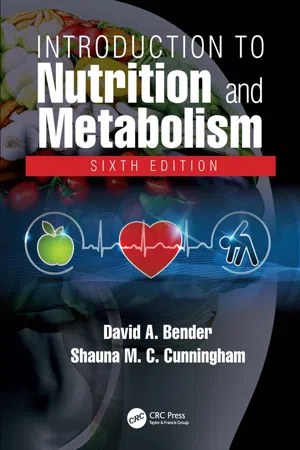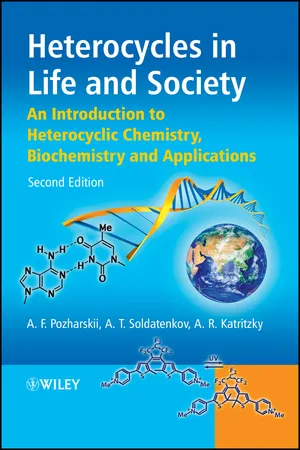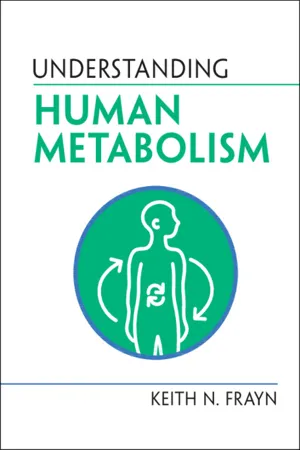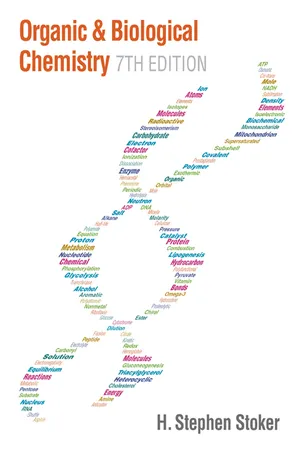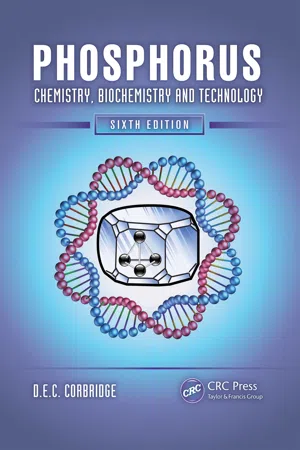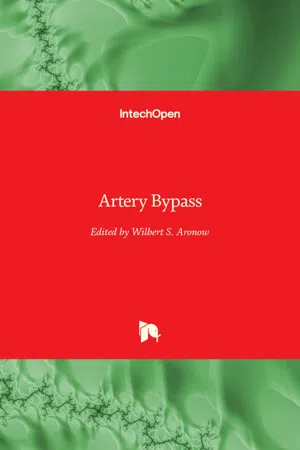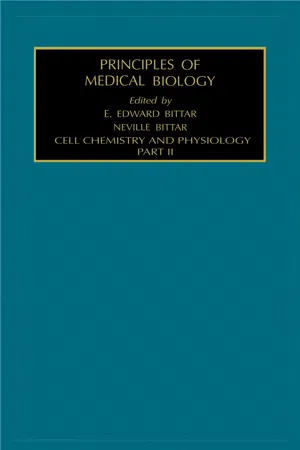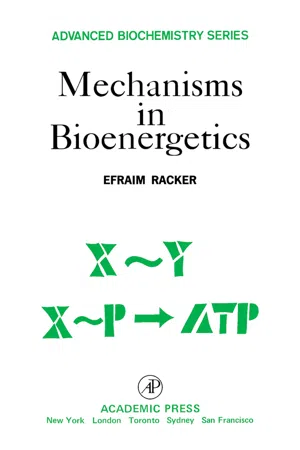Biological Sciences
Adenosine Triphosphate (ATP)
Adenosine triphosphate (ATP) is a molecule that serves as the primary energy currency in living organisms. It is composed of an adenosine molecule and three phosphate groups, which store and release energy through the breaking and formation of chemical bonds. ATP is essential for various cellular processes, including muscle contraction, nerve impulse transmission, and biosynthesis.
Written by Perlego with AI-assistance
Related key terms
1 of 5
12 Key excerpts on "Adenosine Triphosphate (ATP)"
- eBook - ePub
- David A Bender, Shauna M C Cunningham(Authors)
- 2021(Publication Date)
- CRC Press(Publisher)
chapter threeThe Role of ATP in Metabolism
Adenosine triphosphate (ATP) acts as the central link between energy-yielding metabolic pathways and energy expenditure in physical and chemical work. The oxidation of metabolic fuels is linked to the phosphorylation of adenosine diphosphate (ADP) to ATP, while the expenditure of metabolic energy for the synthesis of body constituents, transport of compounds across cell membranes and the contraction of muscle results in the hydrolysis of ATP to yield ADP and phosphate ions. The total body content of ATP + ADP is under 350 mmol (about 10 g), but the amount of ATP synthesized and used each day is about 100 mol (about 70 kg), an amount equal to body weight.Objectives
After reading this chapter, you should be able to:• explain how endothermic reactions can be linked to the overall hydrolysis of ATP → ADP and phosphate• describe how compounds can be transported across cell membranes against a concentration gradient and explain the roles of ATP and proton gradients in active transport• describe the role of ATP in muscle contraction and the role of creatine phosphate as a phosphagen• describe the structure and functions of the mitochondrion and explain the processes involved in the mitochondrial electron transport chain and oxidative phosphorylation, explain how substrate oxidation is regulated by the availability of ADP, and how respiratory poisons and uncouplers act.3.1 Adenine NucleotidesNucleotides consist of a purine or pyrimidine base linked to the 5-carbon sugar ribose. The base plus sugar is a nucleoside; in a nucleotide the sugar is phosphorylated. Nucleotides may be mono-, di- or triphosphates.Figure 3.1 The adenine nucleotides (the box shows the structures of adenine, guanine and uracil; guanine and uracil form a similar series of nucleotides).Figure 3.1 shows the nucleotides formed from the purine adenine – the adenine nucleotides, adenosine monophosphate (AMP), ADP and ATP. Similar families of nucleotides that are important in metabolism are formed from the guanine and uracil bases (see also Section 10.3.2 for a discussion of the role of cyclic AMP in metabolic regulation and hormone action, and Section 10.3.1 - eBook - PDF
- Mary Ann Clark, Jung Choi, Matthew Douglas(Authors)
- 2018(Publication Date)
- Openstax(Publisher)
Gases have higher entropy than liquids, and liquids have higher entropy than solids. 6.4 | ATP: Adenosine Triphosphate By the end of this section, you will be able to do the following: • Explain ATP's role as the cellular energy currency • Describe how energy releases through ATP hydrolysis Even exergonic, energy-releasing reactions require a small amount of activation energy in order to proceed. However, consider endergonic reactions, which require much more energy input, because their products have 184 Chapter 6 | Metabolism This OpenStax book is available for free at http://cnx.org/content/col24361/1.8 more free energy than their reactants. Within the cell, from where does energy to power such reactions come? The answer lies with an energy-supplying molecule scientists call adenosine triphosphate, or ATP. This is a small, relatively simple molecule (Figure 6.13), but within some of its bonds, it contains the potential for a quick burst of energy that can be harnessed to perform cellular work. Think of this molecule as the cells' primary energy currency in much the same way that money is the currency that people exchange for things they need. ATP powers the majority of energy-requiring cellular reactions. Figure 6.13 ATP is the cell's primary energy currency. It has an adenosine backbone with three phosphate groups attached. As its name suggests, adenosine triphosphate is comprised of adenosine bound to three phosphate groups (Figure 6.13). Adenosine is a nucleoside consisting of the nitrogenous base adenine and a five-carbon sugar, ribose. The three phosphate groups, in order of closest to furthest from the ribose sugar, are alpha, beta, and gamma. Together, these chemical groups constitute an energy powerhouse. However, not all bonds within this molecule exist in a particularly high-energy state. - eBook - ePub
Heterocycles in Life and Society
An Introduction to Heterocyclic Chemistry, Biochemistry and Applications
- Alexander F. Pozharskii, Anatoly T. Soldatenkov, Alan R. Katritzky(Authors)
- 2011(Publication Date)
- Wiley(Publisher)
−1 . Thus, units of energy of the same order of magnitude need to be available.The main molecular carrier of energy, the unit of the biological ‘energy coinage’, is the tetraanion of adenosine triphosphoric acid, namely adenosine triphosphate (ATP; at physiological pH, the acidic protons of adenosine triphosphoric acid are almost completely ionized). The mode of action of ATP is based on the hydrolytic elimination of one of the two terminal phosphate groups to form adenosine diphosphate (ADP) or both to form adenosine monophosphate (AMP; Figure 5.1 ). These processes each release approximately 9 kcal mol−1 of energy.Figure 5.1 Hydrolytic cleavage of the phosphate groups of ATP with the formation of ADP and AMP.In some biochemical reactions, energy transfer is carried out by guanosine triphosphate (GTP), uridine triphosphate (UTP) or cytidine triphosphate (CTP). Though there is no evidence yet for the direct participation of the heterocyclic moieties of any of these compounds in the energy transfer, the presence of a purine unit in ATP suggests some function: the heterocyclic bases probably bind the ATP, GTP, UTP and CTP molecules (by noncovalent interactions) to the enzymes which transport them.A number of effects facilitate the liberation of energy by hydrolysis of the pyrophosphate bonds in ATP. First, hydrolysis provides additional negatively charged oxygen atoms. As a result, the products forming on cleavage of ATP are more effectively solvated than ATP itself.2 In other words, the strength of the bonds between phosphate residues in ATP together with the ‘hydration bonds’ between ATP and water are less than the strength of the ‘hydration bonds’ between ADP + phosphate and water.Second, the negatively charged oxygen atoms in ATP mutually repel each other; and when the length of the pyrophosphate chain decreases, the repulsion between the remaining oxygen atoms becomes less pronounced. Moreover, ATP hydrolysis increases the possibility of resonance stabilization in the resulting adenosine diphosphate and phosphate anion compared with the initial molecule of ATP. Overlapping of the unshared electron pairs of such oxygen atoms with the vacant 3d - eBook - PDF
- Keith N. Frayn(Author)
- 2022(Publication Date)
- Cambridge University Press(Publisher)
These bonds are often called ‘high-energy bonds’ Adenosine triphosphate (ATP, a nucleotide) Adenosine (a nucleoside; = sugar + base) Ribose (a sugar) NH 2 N N N N OCH 2 OH OH O O P - O O P - O O P - O O - O O 1’ 2’ 3’ 4’ 5’ Adenine (a base) ~ ~ Figure 5.1 The structure of ATP. The three phosphate groups are on the left. The ‘high-energy’ bonds between phosphate groups are shown as ‘squiggles’ (~), to be discussed shortly. ATP: THE COMMON CURRENCY OF METABOLIC ENERGY 61 although purists in thermodynamics criticise that term – but it’s a useful way of thinking. The German-American biochemist Fritz Lipmann, mentioned in Chapter 3 as the discoverer of coenzyme A, introduced a nomenclature for this, generally called the ‘squiggle bond’, thus: Adenosine-℗~℗~℗, where the squiggles show the bonds that release more energy when broken. Metabolism and Combustion In Chapter 1, we saw Antoine Lavoisier’s conclusion that ‘La respiration est donc une combustion’. As we have seen, within cells, glucose, fats, and amino acids are not actually burned, but are broken down by a series of small steps, that lead ultimately to the same end-products as burning: carbon dioxide and water. The reason for this – apart from the obvious that we don’t want our cells to catch fire – is that the laws of thermodynamics mean that more of the energy can be ‘captured’ in a useful form other than heat. Indeed, as adult humans, we do not use fuels primarily to generate heat – we get plenty of heat as a by-product of metabolism. We use fuels to do other things – physical work is an obvious example, but also making new compounds (e.g. new proteins), keeping the brain thinking, and generally keeping all our cells working. And, to a very large extent, this means that within a cell, the energy from breaking fuels down is captured by making ATP, which can then be used for many cellular processes – all those just listed, and many others. - eBook - PDF
- H. Stephen Stoker(Author)
- 2015(Publication Date)
- Cengage Learning EMEA(Publisher)
Due to electronic rights, some third party content may be suppressed from the eBook and/or eChapter(s). Editorial review has deemed that any suppressed content does not materially affect the overall learning experience. Cengage Learning reserves the right to remove additional content at any time if subsequent rights restrictions require it. 508 CHAPTER 12 Biochemical Energy Production Adenosine Phosphates (ATP, ADP, and AMP) Several adenosine phosphates exist. Of importance in metabolism are adenosine mono phosphate (AMP), adenosine di phosphate (ADP), and adenosine tri phosphate (ATP). AMP is one of the nucleotides present in RNA molecules (Section 11-2). ADP and ATP differ structurally from AMP only in the number of phosphate groups pres-ent. Block structural diagrams for these three adenosine phosphates follow. Phosphate Ribose Adenine AMP Phosphate Phosphate Ribose Adenine ADP Phosphate Phosphate Phosphate Ribose Adenine ATP Figure 12-4 shows actual structural formulas for these three adenosine phos-phates. Highlighted within the structural formulas are the bonds that the phosphate groups participate in. The phosphate–ribose bond is a phosphoester bond, and the phosphate–phosphate bonds are phosphoanhydride bonds. The word anhydride pre-sent in the term phosphoanhydride refers to the production of (loss of) a molecule of water when two phosphate groups bond to each other. A phosphoanhydride bond is the chemical bond formed when two phosphate groups react with each other and a water molecule is produced. In Chapter 5 when inorganic phosphate esters were considered (Section 5-20), the term phosphoryl group was introduced. A phosphoryl group, which has the formula PO 3 2 2 , is the functional group derived from a phosphate ion when the latter becomes part of another molecule. As shown in Figure 12-4, ATP contains three phosphoryl groups, ADP two phosphoryl groups, and AMP one phosphoryl group. - eBook - ePub
- Craig Williams, David James, Cassie Wilson(Authors)
- 2008(Publication Date)
- Routledge(Publisher)
Figure 6.1 ). As each of the high-energy bonds are broken, the released energy can be used by the body in a useful way. The fuel stores within the body are then used to reform the broken high-energy bonds.Since the human body only has a small supply of ATP, it must continually re-synthesise this useful form of chemical energy. In fact, the body can only continue to exercise strenuously for about 2 seconds before the ATP stores would be completely used up if no re-synthesis were to take place. Fortunately, the body is very adept at using the fuel stores to continually re-synthesise the ATP store. To compare the amount of energy stored as ATP within a normal 70 kg body with other types of fuel, it is necessary to convert the size of all the energy stores within the body to the common unit of energy, the joule. Table 6.1 shows the amount of energy which may be contained within each fuel store.Figure 6.1Adenosine triphosphate (ATP) which provides the human body with energy in a form that can be directly usedClearly, the size of each store of energy within the body varies enormously between individuals. However, it is interesting to note that usually the body contains a far greater storage of energy as fat than it does as other forms. Although the store of energy as protein is large, protein is not normally used as an energy source. Carbohydrate energy is very important to the body, especially during exercise; however, the store of energy in this form is far smaller than the store of energy as fat. Even compared with the store of energy as carbohydrate, the ATP energy store is extremely small.MECHANICAL ENERGY
Only a relatively small amount of chemical energy is converted to useful energy in the human body at rest; the remainder being converted to heat. This is why the human body is referred to as being inefficient; something we will be discussing later in the efficiency section (see p. 94). Depending upon the type of activity, about 70 per cent of the chemical energy may be converted to heat during physical activity. - eBook - PDF
- Joyce James, Colin Baker, Helen Swain(Authors)
- 2008(Publication Date)
- Wiley-Blackwell(Publisher)
The condition results in a reduction in the amount of haemoglobin or the number of red blood cells. There are many causes such as pregnancy, chronic blood loss, dietary deficiency and heavy menstruation. Find out about the signs and symptoms of iron-deficient anaemia, how it is treated and who suffers from it. Adenosine triphosphate – ATP Food molecules such as glucose are broken down in the body in a series of enzyme cata-lysed reactions. Each reaction releases a quan-tity of energy. Some of this energy is stored temporarily in molecules of ATP, the rest of the energy is lost as heat. ATP is a nucleotide and consists of a mole-cule of adenine (organic base), the pentose sugar ribose and a chain of three inorganic phosphate groups. ATP is synthesised from adenosine diphosphate (ADP) in the cells of the body (Fig. 10.2). The synthesis of ATP from ADP requires the addition of one phosphate group, a process called phosphorylation. This process of making bonds needs energy and is termed endergonic. When energy is needed by the body ATP is hydrolysed in the presence of the enzyme ATPase. The phosphate bond at the end of the molecule is broken and this releases a quantity of energy, this type of reaction is called exer-gonic. A second phosphate group can also be detached to form AMP (adenosine monophos-phate) releasing a similar amount of energy (Equation 10.1). ATP is not produced and stored in large quantities. Energy is only temporarily stored as ATP and it is therefore not a store of energy as are fat and glycogen, rather a carrier of energy. ATP can be used by the cell to carry out differ-ent types of work, e.g. active transport of sodium ions (Fig. 10.3). When stores of ATP become depleted it can be re-synthesised from ADP in the cell. - eBook - PDF
Phosphorus
Chemistry, Biochemistry and Technology, Sixth Edition
- D.E.C. Corbridge(Author)
- 2016(Publication Date)
- CRC Press(Publisher)
943 Biophosphorus Chemistry CH 2 OH OH O O P O OH O P O OH O C H 2 CH(OH)CH(OH)CH(OH) N N NH N O H 3 C H 3 C O N N N N NH 2 CH 2 N H N NH H N O H 3 C H 3 C O FADH 2 reduced form Flavin adenine dinucleotide FAD (1128) Most known energy carriers are phosphate esters which function as coenzymes (Section 114) These energy carriers are continually being synthesised and then used in a great variety of biochemical reactions which occur in the body and in living cells generally The human body contains about 1 g of ATP, and this is all used up and replaced, on average, every 2 min The three major processes in carbohydrate metabolism, namely the Calvin cycle of photosynthe-sis (Figure 1119), the Embden–Meyerhof scheme of glycolysis (Figure 1120) and the Krebs cycle of respiration (Figure 1121) all require ATP and/or other phosphate esters such as NAD + , NADP + or Acetyl-CoA to act as energy carriers Both ATP and NADPH are involved in the fixation of nitro-gen and numerous other biochemical cycles (Section 115) 11.3.5 N UCLEOSIDE T RIPHOSPHATES CH 2 OH OH O P O O O P O O O P O O O N NH O NH 2 O CTP CH 2 OH OH O P O O O P O O O P O O O N NH O O O UTP CH 2 OH OH O P O O O P O O O P O O O N NH O N N NH 2 O GTP CH 2 OH OH O P O O O P O O O P O O O N NH O O H 3 C O TTP (1129) Closely related to ATP, and present in biological systems, are a number of other nucleoside triphosphates and their corresponding diphosphates and monophosphates These are uridine triphosphate (UTP), cytidine triphosphate (CTP), guanosine triphosphate (GTP), and thymidine triphosphate (TTP), all of which have about the same free energy of hydrolysis as ATP (1129) In addition there are the deoxy nucleoside triphosphates (Chapter 104) The molecular conformations adopted by these energy-carrying compounds will be influenced by crystal structure, enzymes present, bonding to metal ions and other factors (Figure - eBook - PDF
- Wilbert S. Aronow(Author)
- 2013(Publication Date)
- IntechOpen(Publisher)
© 2013 The Author(s). Licensee InTech. This chapter is distributed under the terms of the Creative Commons Attribution License http://creativecommons.org/licenses/by/3.0), which permits unrestricted use, distribution, and reproduction in any medium, provided the original work is properly cited. 2. Adenosine triphosphate depletion Eukaryotic cells contain mitochondria, organelles whose main function is to produce adeno‐ sine triphosphate (ATP). ATP is an essential energy substrate, as its hydrolysis provides en‐ ergy for many metabolic and biochemical reactions involved in development, adaptation and cell survival. ATP production in an aerobic cell is particularly effective when the degra‐ dation of key nutrients such as glucose and fatty acids is coupled to a supramolecular com‐ plex located in the inner membrane of mitochondria to drive oxidative phosphorylation. Oxidative phosphorylation is mediated by an electron transport chain that consists of four protein complexes and establishes a transmembrane electrochemical gradient by supporting the accumulation of protons in the intermembrane space of the mitochondria. This gradient is used as an energy source by ATP synthase during the synthesis of an ATP molecule from a molecule of adenosine diphosphate (ADP) and an inorganic phosphate (Figure 1). Without oxygen, oxidative phosphorylation stops: the proton gradient between the intermembrane space and the inner mitochondria is abolished, and ATP synthesis is interrupted. The ensu‐ ing rapid fall in intracellular ATP induces a cascade of events leading to reversible cell dam‐ age. However, over time, the damage increases and gradually becomes irreversible, which may lead to cell death and destruction of the parenchymal tissue. - eBook - ePub
- Jennifer Guercio, Michael D'Alessio, Lauren Gross(Authors)
- 2013(Publication Date)
- Research & Education Association(Publisher)
Endergonic reactions require free energy.A + B + Energy → ABi. In anabolic reactions , reactant(s) are joined together to produce product(s) containing more energy.ii.Thefree energy required by anabolic reactions is often provided by ATP produced in catabolic reactions.3.Adenosinetriphosphate (ATP) carries energy in its high energy phosphate bonds.i. ATP is formed from adenosine diphosphate (ADP) and inorganic phosphate.ADP + Pi + Energy → ATPii.Conversely,when ATP is broken down into ADP and Pi via hydrolysis, energy is released (exergonic ) that can be used in endergonic reactions.iii. In addition, ATP can donate one of its phosphate groups to a molecule, such as a substrate or a protein, to energize it or cause it to change its shape.4. Living systems require a consistent input of free energy and an ordered system.i. This free energy input allows for a system’s order to be maintained.ii. If either order in the system or free energy flow were to occur, death can result.iii. Biological processes are in place to help offset increased disorder and entropy and to help maintain order within a system; therefore, energy input into the system must exceed the loss of free energy in order to maintain order and to power cellular processes.iv.Energystorage and growth can result from excess acquired free energy beyond the required energy necessary for maintenance and order within a system.v. Changes in free energy can affect population size and cause disruptions to an ecosystem.5.Metabolism—the totality of all chemical reactions that occur within an organism.i. - eBook - PDF
- Edward Bittar(Author)
- 1996(Publication Date)
- Elsevier Science(Publisher)
The role of ATP in biosynthesis is to activate a molecule for further reaction. Two classes of reaction can be distinguished, ATP as a Dehydrating Agent As noted above, macromolecules are assembled by reacting component mono-mers with the elimination of water (condensation). ATP is an acid anhydride; it can therefore, in principle, drive condensation reactions. It must, however, specifically remove that water formed in the reaction, in the presence of a large excess of cell water. This requires the direct reaction of ATP with one of the reacting species. Typically, ATP will activate organic acids (amino acids, fatty acids), forming an adenylated intermediate (mixed acid anhydride). This reaction would be barely favorable if Pj were released; however, PPj is released, and this is rapidly hydro-lyzed by cellular pyrophosphatase, ensuring complete reaction. O II (i) R-COO + ATP -> R-CO-P-adenosine + PPj (ii) PPi+H20 -> 2?^ I O The adenylated intermediate is too unstable to release into free solution, and so the activated acid is transferred to a carrier molecule, tRNA in the case of amino acids and coenzyme A for fatty acids (Figure 9). However, the carboxylate group is still in an anhydrous state, and these species will react with the acceptor molecule (R-NH2 for amino acids, glycerol(-OH) for fatty acids) without further energy input. In the synthesis of polysaccharides, the dehydrating agent is a different nucleo-side triphosphate, UTP. This replaces, in an analogous reaction, a sugar hydroxyl (alcohol) group forming the UDP-sugar compound, which can transfer the activated sugar on to the -OH of a growing polysaccharide chain. Activation of Leaving Groups A number of biochemical reactions involve the displacement of a hydroxyl group by another group (e.g., an amino group). However, the -OH group is chemically a very poor leaving group, i.e., it shows a strong tendency to remain attached to its neighboring carbon atom. - eBook - PDF
- Efraim Racker, Anthony San Pietro(Authors)
- 2014(Publication Date)
- Academic Press(Publisher)
PART I Formation of Adenosine Triphosphate in Soluble Systems This page intentionally left blank LECTURE 1 GENERAL CONSIDERATIONS OF ENERGY PRODUCTION Common, unendingis the sisters'pathway; taught by the gods, alter-nately they travel; Fair-formed, of different hues,and yet, one-minded, they clashnot, neither do they tarry. * * * Transversely was their severing line extended: what was above it then and what below itt There were begetters, therewere mighty forces,free action here and energy up yonder. —The Hymns of the Rig-Veda Cells require energy in order to live. Without a supply of energy, cells cease to grow, to move, or to transport ions, and eventually die after exhausting their reserves of metabolically combustible substrates. Chlorophyll-containing cells obtain energy from light, and some microorganisms can oxidize inorganic substrates, but most animals depend on organic matter, synthesized by plants, for their supply of energy. The process of converting these nutrients into forms of useful energy is the essence of energy metabolism. In this field of activity, one can distinguish between general practitioners of energy production, and specialists. The general practitioners utilize the multi-enzyme systems of (1) glycolysis, (2) oxidative phosphorylation, or (3) photo-phosphorylation. These processes are widely distributed in nature and are not exclusive of each other. Most animal cells utilize glycolysis as well as oxidative phosphorylation, and plant cells also catalyze photophosphorylation. On the other hand, there are microorganisms that utilize only glycolysis or only oxidative phosphorylation for energy production. The acquisition by microorganisms of multiple pathways of energy 3 4 1. General Considerations of Energy Production production probably contributes greatly to their survival under unfavorable conditions. Then there are the specialists in energy production.
Index pages curate the most relevant extracts from our library of academic textbooks. They’ve been created using an in-house natural language model (NLM), each adding context and meaning to key research topics.
